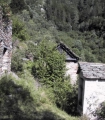 |
|
|
|
|
|
|
Because alpine pasturing today is often unprofitable, many alpine pastures, especially those at higher altitudes, on steep slopes, or in shady sites have been abandoned or are managed very extensively. |
| Drag the different consequences to the corresponding management practices. |
|
With very extensive management and after abandonment the sudden occlusion of previously intact drainage systems may occur and result in over-saturation of soils and soil erosion. |
|
After abandonment, successional changes occur leading towards the type of vegetation occurring naturally under those particular environmental conditions. The sequences of vegetation changes depend on altitude and other habitat characteristics like soil moisture and nutrient availability. |
1 - Abandoned goat pasture (73K) |
|
Abandoned pastures above the treeline often return directly to a vegetation similar
to the natural state without a sequence of intermediate plant communities. But it may take a very
long time for the vegetation of a fertilized pasture to return to a condition resembling the natural
vegetation. Below the treeline, succession generally passes through different stages before climax
vegetation is reached. Abandonment of grazing is usually followed by a stage of tall grasses and
forbs. This vegetation may enhance a particular type of erosion: this occurs in winter when snow
freezes to the long plants and uproots them as the snow-pack creeps downslope (turf-erosion). The risky transition period back to a more stable ecosystem without domestic livestock may take at least half a century, but sensitivity varies greatly with slope and vegetation type. When alder, dwarf shrubs and young trees overgrow pastures, a general stabilisation of the terrain occurs. Total runoff during an artificial rainfall experiment on an abandoned pasture covered by a dense stand of green alder was only about 16%, whereas it was between 35 and 71% on an adjacent, intensively managed pasture. Complete abandonment would lead to a reduction in vegetation types and species richness. |
29 August 2011 |
||
| |
||
